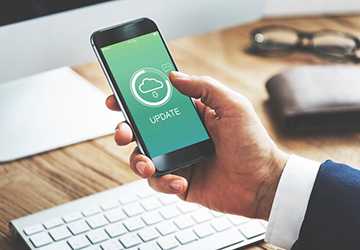In today's digital age, we juggle multiple devices like smartphones, tablets, laptops, and even smartwatches. Each serves a unique purpose but managing them efficiently can be a headache. Enter device synchronization – a simple yet powerful solution that can make your life easier. This article will explore tips to help you sync all your devices seamlessly without getting lost in corporate jargon.

Choose the Right Ecosystem
The first step in syncing your devices is to choose the right ecosystem. Ecosystems are like digital universes created by tech giants, including a range of products and services that work seamlessly together. Apple's iOS/macOS and Google's Android/Chromeo’s are the two most popular ecosystems. If you're already invested in one of these ecosystems, it's often easier to stick with it. However, consider your needs and preferences if you're starting from scratch or open to change. Do you want a highly customizable system, like Android, or one known for its ease of use and tight integration, like iOS? Your choice can significantly affect your device syncing experience.
Use Cloud Services
The magic of device synchronization primarily revolves around cloud services. Cloud services allow you to store and access your data, like photos, documents, and apps, anywhere on any device. Here are a few cloud services you can use: Apple iCloud: If you're in the Apple ecosystem, iCloud is your go-to option. It seamlessly syncs photos, videos, contacts, and documents across your Apple devices. Google Drive: Google Drive is great for those in the Android ecosystem. It offers generous free storage and integrates with Google Docs, Sheets, and Slides. Microsoft OneDrive: If you're using Windows devices, OneDrive is a powerful choice. It syncs your files and photos and offers integration with Microsoft Office applications. Dropbox: Dropbox is a cross-platform cloud service. It's known for its simplicity and ease of use and works well across different ecosystems. Sync Across All Devices: Once you've chosen your cloud service, ensure you've installed its app on all your devices. This way, your data will be automatically synced. For instance, taking a photo on your smartphone will appear on your tablet and computer if they're connected to the same cloud service.
Set Up Automatic Backups
Imagine losing all your important data due to a device malfunction or theft. To avoid such nightmares, it's crucial to set up automatic backups. This ensures that your data is regularly saved in a secure location. Here's how to do it: iOS: If you're using an iPhone or iPad, enable iCloud Backup. Go to "Settings" > "Your Name" > "iCloud" > "iCloud Backup," and turn it on. Your device will automatically back up when connected to Wi-Fi and charging. Android: You can use Google's built-in backup service on an Android device. Navigate to "Settings" > "System" > "Backup," and turn on "Back up to Google Drive." Your device will automatically back up app data, call history, and settings. Windows: If you're a Windows user, OneDrive can automatically back up your files and photos. Ensure that the "Autosave photos and videos to OneDrive" option is turned on in your settings. Mac: On a Mac, Time Machine is your best friend for automatic backups. Connect an external hard drive and follow the on-screen prompts to set it up. Automatic backups are a lifesaver. They ensure your data is safe and accessible even if one of your devices encounters a problem.

Keep Your Apps and Software Updated
Another critical aspect of seamless device synchronization is keeping your apps and software up to date. This might seem minor, but it can make a significant difference. Here's why: Compatibility: App and software updates often have bug fixes and compatibility improvements. These ensure that your apps run smoothly across different devices. Security: Updated apps and software are less vulnerable to security threats. Staying current with updates is your first defense against hackers and malware. New Features: Updates can bring exciting new features and enhancements. These can improve your user experience and make your devices work even better together.
To update your apps and software:
iOS: On an iPhone or iPad, go to "Settings" > "General" > "Software Update." If there's an update available, follow the prompts to install it. Android: On an Android device, go to "Settings" > "Software Update" or "System Updates." If an update is available, follow the on-screen instructions. Windows: You can update your software on Windows devices through the "Windows Update" settings. Go to "Settings" > "Update & Security" > "Windows Update." Mac: Software updates are typically found in the "App Store" under the "Updates" tab. Take your time with updates. They are your ticket to a smoother, more synchronized experience across your devices.
Organize Your Data
Last but not least, maintaining a well-organized data structure can work wonders for device synchronization. A little organization goes a long way, whether it's your photos, documents, or apps. Here's how to do it: Photos: Use folders or albums to categorize your photos. For instance, create folders for family, vacations, work, etc. This makes it easier to find the picture you're looking for, regardless of the device you're using. Documents: Organize your documents into logical folders. For example, create folders for work, personal, and miscellaneous files. Use clear, descriptive file names to help you identify them quickly. Apps: Arrange your apps in a way that makes sense—group similar apps on your device's home screen. Delete apps you no longer use to keep things clutter-free. Sync Settings: Some apps and services allow you to customize their synchronization settings. Take a few moments to review and adjust these settings to suit your needs. For instance, you can sync only specific folders in your cloud storage or enable automatic syncing at certain times. By keeping your data organized, you'll be able to find what you need quickly, no matter which device you're using. This can significantly enhance your overall syncing experience.
Conclusion
Syncing all your devices seamlessly is not as complex as it may seem. You can enjoy a smoother and more efficient digital life by choosing the right ecosystem, using cloud services, setting up automatic backups, keeping your apps and software updated, and organizing your data. With these tips in mind, you'll be well on your way to mastering the art of device synchronization without the need for corporate jargon or technical expertise. Happy syncing!